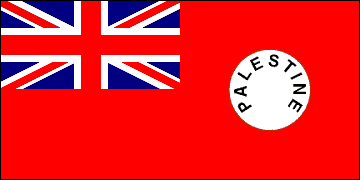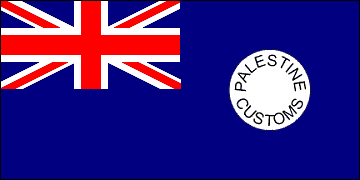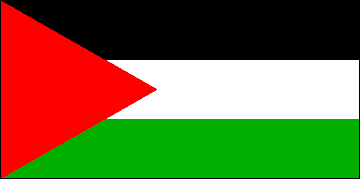FLAGS OF MANDATE PALESTINE
BRITISH ADMINISTRATION • 1920-48
The British Mandate for Palestine, granted by the League of Nations, covered territories formerly part of the Ottoman Empire. It was established in 1920, confirmed by the League on 24 July 1922, and came into effect with the ratification of the Treaty of Lausanne between the Allies and Turkey on 29 September 1923. Under the terms of the Mandate, Great Britain was to administer Palestine temporarily, taking such measures as necessary to prepare the territory for independence. Mandate Palestine originally included Trans-Jordan but in 1921 a separate administration for this territory was established, headed by the Hashemite Prince Abdullah bin Hussein, and in 1928 Trans-Jordan became largely autonomous. Thereafter the Mandate for Palestine encompassed two distinct polities: Palestine proper (present-day Israel plus the West Bank and the Gaza Strip) under direct British administration and autonomous Trans-Jordan.
The wartime Balfour Declaration had promised the establishment of a “national home for the Jewish people” in Palestine and Jewish immigration was accordingly permitted, though only into the territory under direct British administration. Though the influx of Jews facilitated considerable economic development it was bitterly resented by the Arab population. Sectarian strife eventually culminated in the Arab Revolt of 1936-39. This was put down by the British with Jewish assistance and considerable bloodshed. The revolt was a decisive event in the history of Palestine, making clear that the Jews and the Arabs would never collaborate in the establishment of a nonsectarian state. Thus was born the concept of partition, which was finally given expression in the UN resolution of 29 November 1947.
The end of the Second World War heralded the final act of the Mandate. European Jews, survivors of the Holocaust, flooded into Palestine despite British efforts to stop them. Tensions between the Arab and Jewish communities reached boiling point and British authority began to break down. On the heels of the UN partition vote, which proposed to divide Palestine into separate Jewish and Arab states, the British government notified the UN that it would terminate the Mandate no later than 14 May 1948. Meanwhile, though the Jews accepted the UN plan the Arabs rejected it. As the British drew down their forces, sectarian fighting intensified. On the afternoon of 14 May the State of Israel was proclaimed in Tel Aviv and at the stroke of midnight the British Mandate for Palestine was formally terminated.















